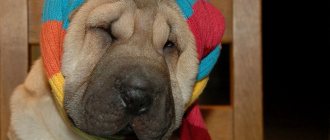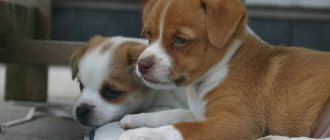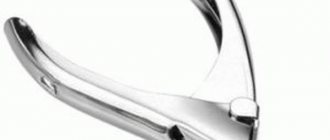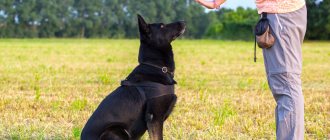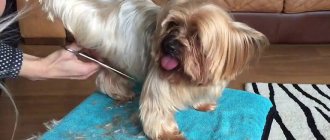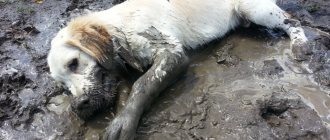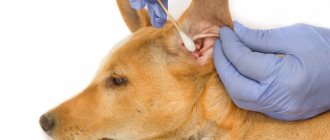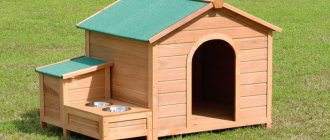Is it necessary to bathe a dog at all?
In fact, it is not at all necessary to do this regularly. There is no need to rinse off sweat, since dogs do not produce it, and the coat is capable of self-cleaning.
They resort to washing only as a last resort, if the dog is very dirty after a walk or smells of carrion (this happens with hunting breeds), according to indications from a veterinarian for skin diseases or the presence of parasites, as well as on the eve of an exhibition where the condition of the coat is assessed, and even after haircuts to wash off the remains of the cut wool.
Some owners wash their dogs because they sleep on the owner's bed or on the sofa. Of course, you want your pet to not smell of anything.
You should wash your paws every day after walks. And if your dog gets dirty with food during a meal, you can wash its face.
How often should you wash your dog unless it's an emergency? Veterinarians recommend doing this no more than once a month. In general, the frequency depends on the breed, length and structure of the coat. Some people need the procedure weekly, while others need it once every 2-3 months.
How much water does your dog need?
Here are the various factors you should consider when determining how much water your dog needs:
According to experts, a dog should drink about 30–60 ml of water per kilogram of body weight per day. So if your pet weighs 5 kilograms, he should drink 150-300 ml per day.
● Amount and type of food consumed
If your dog eats wet food, he will usually need less water. But if she eats dry food, more moisture is needed. How many? Here's one general rule: Your dog should drink about 2.5 times the weight of the dry food he eats. If the daily food intake is 300 grams, then water is 750 ml.
● Pregnant and nursing dogs
During pregnancy and lactation, your dog often needs three to four times more water than she normally drinks to provide her puppies with enough milk and meet her own fluid needs.
During the summer or in hot climates, your dog needs three to four times more fluid than he normally drinks.
Dogs that lead an active lifestyle tend to consume more moisture.
Which dogs are rarely washed?
There are decorative dog breeds. They are very small. They are carried outside in their arms, and they go to the toilet right in the house in a tray or on a diaper. Therefore, they are washed infrequently.
- Dogs with long, smooth hair prefer to be combed rather than washed. During the process, the wool is cleaned of contaminants.
- Dogs with thick undercoat that are constantly kept in an enclosure are washed only as a last resort. Their fur deteriorates from washing, and the sebaceous glands begin to malfunction.
- Puppies are not bathed until they begin walking regularly. As long as they are unfamiliar with the street, this is not necessary.
- You cannot wash your dog two days before vaccination and for 10 days after. If treatment for parasites is planned, then washing should be done a week before treatment, and repeated no earlier than a week later.
Nursing and pregnant dogs can only be washed if they tolerate the procedure well. If the animal is nervous, it is better to delay washing.
What tools should be used
For care, it is recommended to use special cosmetics for dogs. Other products may harm your pet's health and cause skin problems.
Shampoos designed for a person’s acidity level are dangerous: they greatly dry out your pet’s already thin skin.
Dog skin is different from human skin: it is thinner and has a different level of acidity. Therefore, shampoos designed for a person’s acidity level are dangerous: they greatly dry out your pet’s already thin skin. The choice of product also depends on your pet's skin and coat type. Currently, there are a huge number of varieties of shampoos: for short, long, curly, straight, white, black hair, for sensitive skin, for puppies and so on. The brands Francodex, Iv San Bernard, Beaphar, Perfect Coat, Bio Groom have extended lines of shampoos.
There are also leave-in shampoos in the form of a spray or powder. They are convenient if you do not have the opportunity to bathe your pet. It is also recommended to use such products for dogs that cannot tolerate the washing procedure. Biogance, Pet Head, Beaphar, Espree have dry shampoos.
Which dogs are washed frequently?
There are breeds with thick and long hair: Newfoundlands, Bobtails, St. Bernards and others. Their fur gets dirty quite often and needs to be washed.
The same applies to white and light-colored dogs, as well as those whose skin has many folds - pugs, sharpeis.
- Show dogs, whose fur is very similar in texture to human hair, also need frequent bathing.
- Dogs have periods of shedding. The fur falls out and needs to be combed out, and the remains washed out with water and shampoo.
While walking, city dogs are more likely to bring home particles of exhaust gases, soot, and reagents than village dogs. Therefore, city dogs are washed more often.
Dog breeds that tolerate cold well
Alaskan Malamute, Siberian Husky, Akita, German Shepherd, Caucasian Shepherd, East European Shepherd, Belgian Shepherd, White Swiss Shepherd, South Russian Shepherd, Australian Shepherd, Anatolian Shepherd, Bobtail, Chow Chow, Czech Wolfdog, Moscow Watchdog, Great Pyrenees mountain dog, St. Bernard, Rottweiler, Leonberger, Tibetan mastiff, Norwegian Elkhound, Grosser, Samoyed, Bernese Mountain Dog, long-haired collie, black terrier, Sheltie, Irish wolfhound.
The process of bathing a dog
To wash your dog in the bath, you need to prepare for this process.
The preparation is as follows:
- Close all windows and doors to prevent drafts, otherwise the animal may catch a cold.
- Cover the bathroom floor with old rags to prevent your dog from slipping if he decides to jump out of the bath.
- It is also necessary to prevent the possibility of slipping in the bathtub itself by laying a rubber mat on its bottom.
- It is better for the owner to put on clothes that he doesn’t mind getting dirty or wet, and the pet can also cling to it and tear it.
- The dog's fur needs to be inspected, tangles should be cut off or combed, and the parasite collar should be removed.
- If a dog does not tolerate washing well and tries to bite, it is better to put a muzzle on it, and if it tries to jump out of the bath, then also a leash.
The bathing container is selected depending on the size of the dog. A large one can be placed in a bathtub, a small one in a baby bath, and dwarf breeds can be bathed in a basin. In the video on how to wash a dog, you can get acquainted with this procedure in detail, but you need to be prepared for various surprises.
The water temperature should be no lower than 35 degrees and no higher than 40. Hot water will be uncomfortable for the dog and can cause deterioration in the condition of the coat.
You need to pour water on the fur of a dog standing in the bath and wet it all. Avoid getting water into your ears and eyes. You can put earplugs in your ears. Dogs with cropped ears do not have their hair washed.
Beginning dog owners always have a question: is it possible to wash a dog with human shampoo?
- Veterinarians unequivocally answer that it is impossible, except perhaps in force majeure circumstances. Dogs and people have different pH levels.
- Human shampoo can cause allergies or hair loss in your pet.
- Therefore, you should stock up on several shampoos specifically for dogs, including antiparasitic ones.
- The shampoo is applied to the wool not directly from the bottle, but after diluting it with water: 1 part special shampoo, 5 parts water.
- You also need to wash your dog’s private parts. After thorough washing, you can rinse off the foam, especially from the armpits, skin folds and neck area.
- If it so happens that the dog gets very dirty during a walk or is found after several days of wandering on the street, you can re-soap it and rinse it again.
Once all the foam has been washed away and most of the water has drained away, you can apply conditioner (for dogs!) to a dog with long, smooth hair. After a certain time it must be washed off. This product makes it easier to comb the hair.
A dog that is bathing for the first time, and this can happen if it was taken from the street, needs to be encouraged in every possible way, not to make sudden movements, not to jerk, not to scream, and especially not to hit. Over time, she will get used to the procedure and will behave more calmly.
Feeding the dog in winter
Changing their diet in winter is important for working and outdoor dogs because they need more energy to generate heat. First of all, it is necessary to increase the calorie content of foods, but not the serving size. However, if when feeding natural products you can increase the calorie content by adding vegetable oil, offal, boiled udder, beef tripe and trimmings with a fatty layer, then when feeding dry food it is difficult to do this. In this case, you can replace the usual food with food for active dogs (Bosch Active) or gradually increase the portion size, for example, if in the warm season the pet consumed 600 grams of dry food, then in winter it will need 800 grams. It is important to prevent a lack of vitamins E and B; to do this, you need to introduce foods rich in these vitamins into your diet or give additional vitamin supplements.
The water problem can be solved. Of course, some dog breeders are ready to regularly add boiling water to a dog living on the street so that the water does not freeze, but this option is not the best. In winter there is a lot of snow, which animals eat if they are thirsty. During the period when it is already cold outside, the water is freezing, but there is no snow yet, you can give your pet a piece of ice that he will lick. There is no need to worry that your pet will get sick, because the animal swallows a small amount of snow, which manages to warm up before it reaches the stomach. Some enterprising owners place a special mat (for example, for reptiles) in the enclosure to heat the water. In this case, care should be taken to ensure that the animal does not chew through the wires.
Food for dogs that live on their faces should be given warm in a plastic bowl (the tongue may stick to a metal bowl), but it is not recommended to fill dry food with warm water because it hardens quickly, and some dogs refuse soaked dry kibble.
Changes in diet should not affect low-active pets living in apartments. They do not need to expend energy, they are always warm, and increasing the calorie content of food will lead to obesity.
It is worth considering when feeding dogs in winter that females spend less energy than males, young dogs need more food than older dogs.
How to dry a dog
The pet should be taken out of the bath by the owner, and not allowed to jump out.
- Firstly, she may run suddenly and slip.
- Secondly, then everything in the apartment will be in the water from the wool.
- Having taken the dog out, you need to put it on a towel and blot its fur with another towel.
- For a large dog, you will need several towels. Then let the wool dry naturally.
- As a last resort, use a hairdryer and turn it on at room temperature.
After the fur is completely dry, you need to comb it. If you do not wait until it dries completely, wet wool hairs will break. After washing your dog, it is advisable to walk him only a couple of hours later, as he may catch a cold from the temperature change.
Caring for a dog in winter
By following simple rules for caring for animals in winter, you can protect your pets from a number of dangers.
Decorative breeds living in an apartment need warm everyday clothing, because they do not tolerate cold well and can freeze even in a heated room.
Like humans, animals, when they are cold and try to curl up into a ball, look for a cozy and warm place in the house. Therefore, you should take care of a sleeping place in which the animal will sleep comfortably.
How to wash your paws after a walk
If it’s slushy outside, you have to wash your dog’s paws after every walk.
- To do this, you should leave a bowl of water and a towel in the hallway so that you can come in from outside and immediately wash your paws.
- And also fur on the belly if it gets into a puddle.
- After this, wipe the paws with a towel and, if necessary, lubricate with cream.
- It will help relieve discomfort if the dog gets scratches while walking, as well as if the skin is rough.
What are the signs that your dog is about to die?
- Loss of interest. As a dog approaches death, it may begin to lose interest in things and people around them. ...
- Extreme fatigue or loss of energy. One of the most common signs that a dog may be dying is a severe loss of energy. ...
- Loss of bladder and bowel control. ...
- Change in appetite or loss of appetite. ...
- Strange breathing.
THIS IS INTERESTING: What is a level 5 dog?
16.08.2018
What if the dog smells strongly?
How to wash a dog from the smell if it is pronounced?
- Dilute 1 tablespoon of vinegar in 250 ml of warm water, soak a sponge in the solution and wipe the animal’s fur with it.
- This method should only be used as a last resort, as it can dry out the dog’s fur and skin.
A very strong specific smell from a dog should alert you. This may be a symptom of a disease, which will be announced by the veterinarian at the clinic.
Now you know everything about how to wash a dog.
If the temperature is higher than normal
When the water temperature rises above 40°C, it can be uncomfortable for your dog as it increases the heart rate and can put strain on the heart, especially in older, younger and unhealthy dogs. This is why it is always better to keep the water warm.
You should always make sure your dog has a positive bath experience from an early age. This will ensure that bathing remains a fun and enjoyable experience for both owner and dog, and will also help them learn to groom themselves.
Photo instructions on how and what to wash your dog with
Main symptoms
The first signs of eczema can be difficult to detect due to the dog's long or thick coat. Only the owner’s attention to the pet’s unusual behavior will help identify the onset of the disease. Such signs may be:
- The animal scratches and licks the same place repeatedly and forcefully, sometimes whining from the onset of pain due to itchy inflammation.
- At the site of licking, the fur does not fit (stands on end) in the direction of growth of the general coat, its loss is noted, and in advanced cases - baldness.
- Upon careful examination, redness and a rash on the skin, up to a local increase in temperature, are observed in areas where scratching is made.
- Soreness - the dog does not allow you to touch the places that bother you.
- The wet surface of any part of the body is detected. Dogs do not tend to sweat, so the formation of a wet patch of skin indicates the occurrence of weeping eczema.
- Rough compactions of the skin in places where scratching with signs of peeling indicate the occurrence of dry eczema, which has become chronic.
- Changing your pet's behavior. In the absence of obvious concern for the dog about itchy skin inflammation, the disease can occur in a latent form. With this development, signs of general malaise appear, in which, against the background of intoxication of the body, the pet experiences loss of appetite, thirst, and lethargy.
Having discovered symptoms of eczema, you should not take independent measures to treat the disease due to the difficulty of classifying the causes of its occurrence. Self-medication can harm and aggravate the situation of the pet, turning the disease into a chronic form, ensuring its constant relapses.
Preparing for a swim
Before you start thoroughly washing your dog, you should first examine it for open wounds and other injuries for which bathing is not recommended.
You should also comb your pet thoroughly and remove any tangles, especially for long-haired breeds.
Before washing the room, you should close the windows, avoid drafts and cool air temperatures, since after bathing a wet dog will dry for several hours and may become hypothermic.
Don't forget to place a rubber mat or towel on the bottom of the bathtub or shower stall to prevent paws from sliding across the surface and claws from damaging the surface itself.
Keep in mind that after bathing, the dog will definitely shake himself off and splashes will fly everywhere, so prepare the room for this in advance, and also be prepared - wear suitable clothes, preferably with long sleeves, as the dog may accidentally scratch you.
Stock up on enough towels to absorb as much moisture as possible from your pet's fur after bathing and prevent this moisture from ending up throughout the house.
Special clothing and shoes
It is better to equip four-legged animals without undercoat, with short or no hair, as well as older animals, with special clothing for dogs. Thanks to it, the pet's body will remain warm longer. Some models made from waterproof fabrics also protect the animal's fur from moisture and getting wet.
In winter, dogs' paws suffer the most.
They quickly cool down and are injured, for example, by pieces of ice. Injuries are further irritated by salt deposits on roads and sidewalks, which can cause pain. In addition, dogs usually like the salty taste, so you should pay attention to whether your pet licks its paws after walking on the ground. This can lead to serious poisoning. There are also special shoes for dogs on the market that protect the animal's sensitive paws. In a situation where your four-legged friend cannot get used to shoes, you can apply a protective ointment to the paw pads.
Treatment method and prognosis
When treating eczema, there is a rule: drying for wet eczema, moisturizing for dry.
For local therapy, antibacterial and regenerating compounds are used as prescribed by a doctor.
The doctor's recommendations for visiting the clinic for regular examination of the pet are followed.
When positive changes slow down, the doctor changes medications due to the animal’s body getting used to it and reducing the therapeutic effect.
For high-quality treatment of the affected area, it is necessary to carefully cut the hair from the damaged area. This can be done at home or performed in a clinic with the help of trained professionals.
To eliminate disturbing itching, the veterinarian prescribes a drug that relieves its symptoms; in case of nervous shock, sedatives can be prescribed; in case of severe pain, painkillers are used.
Treatment of eczema is a long process during which the condition may return or worsen if treatment is interrupted when the owner has noticed improvements. This is a gross human mistake: interrupting the healing process throws all efforts back and allows the disease to progress again. This treatment can last for months.
If you follow all the instructions and go to the clinic in a timely manner, healing may take about two weeks.
conclusions
Keeping your pet clean is important for its health. Depending on the breed and condition of the dog, the frequency of bathing varies. The procedure is carried out competently so as not to frighten the animal. Proper bathing ensures safety for the pet and its owner. Do not forget that after a walk, the dog needs to be partially washed - without soap and shampoo. To maintain hygiene, it is recommended to alternate dry shampoo and classic detergents.
Read more: Rating of anti-flea shampoos.
Diagnostics in a veterinary clinic
If you notice signs of eczema, you should consult a specialist. It is advisable not to put off the visit and not self-medicate. This can blur the picture of the course of the disease and complicate the identification of the causes of the disease.
The doctor examines the dog, listens to the owner about the animal’s lifestyle, when the inflammation was detected and other details.
To exclude the parasitic nature of the development of the disease, the doctor prescribes unscheduled treatment of the pet for parasites and worms.
If a dog has chafing on its body from a collar, harness or other devices, then the doctor’s recommendation would be to remove these accessories, select the size or replace them with others made of different materials and of higher quality.
As for tests, as a rule, a biochemical blood test, a urine test, a blood test for allergic status, and an ultrasound of the abdominal organs are prescribed.
If a food allergy is suspected, the doctor may prescribe a blood test to determine sensitivity to menu components.
Making a diagnosis is a serious matter, since it is associated with identifying a malfunction in the processes of the animal’s body.
Therefore, without waiting for tests and results of prescribed examinations, the doctor determines medications for local treatment of identified skin lesions.
What to do at home
At home, it is necessary to perform hygiene procedures and properly treat the damaged area.
The dog should be in a comfortable environment and not be bothered by the itchy wound. It is necessary to ensure that all prescribed medications provide an antipruritic, antibacterial and analgesic effect. If the effect of the drugs decreases, you should consult a doctor to change the therapy, as the dog’s body could get used to the drugs and slow down the healing process.
At home, strict compliance with the veterinarian’s prescriptions without deviations from the prescribed course of treatment is required.
Therapeutic wash: features and tips
Bathing dogs with confirmed diseases involves the use of not only cosmetic, but also medicinal products. The most common problems include:
- Seborrheic dermatitis.
The appearance of dandruff is a consequence of dry skin. To eliminate it, moisturizing, antipruritic and wound-healing drugs are used.
- Flea infestations.
Antiparasitic shampoos are made based on herbs. They not only repel fleas, but also restore damaged skin.
- Lichen.
Eliminate with antifungal agents. Due to contagiousness, the procedure is carried out with protective gloves.
In addition to those listed, there are other skin pathologies. If your pet is sick, be sure to check with your veterinarian about what is best to wash it with.
Conditions for bathing puppies
Small unvaccinated puppies at the age of 4 months cannot be bathed, but there are times when washing is necessary - for example, if the puppy has lived on the street for a long time. How to wash a puppy for the first time?
- Prepare to wash your puppy . Check that all windows in the apartment are closed and there are no drafts. The bathroom should be warm.
- The puppy may be afraid of being washed in the shower . Fill a bowl with warm water so that its level reaches the puppy’s tummy. To wet the entire coat, water it with your hands.
- The puppy may panic - distract him with a toy or treat, talk in a gentle voice, praise him when he behaves well.
- Use a special shampoo for puppies , gently apply soap lather to the dog, massage and then rinse with warm water.
- After bathing, dry the puppy well and wrap it in a towel.
Is it possible to wash after vaccination?
Any intervention in the body is stressful for the dog. Vaccination is a medical procedure to inject a weakened virus. In the process, immunity to this disease is formed. After vaccination, the pet’s body is weakened, because fights viruses. Usually the animal is quarantined for two weeks and its condition is monitored.
At this time, it is better to avoid swimming with detergents.
Use alternative care methods. Products containing chemicals should be chosen with caution. Allergic reactions complicate the recovery period. Small puppies are most susceptible to colds after vaccination. Swimming can cause infection and the onset of illness.

